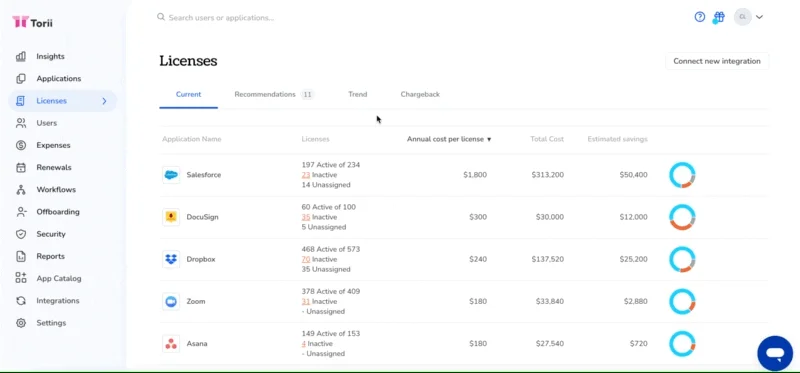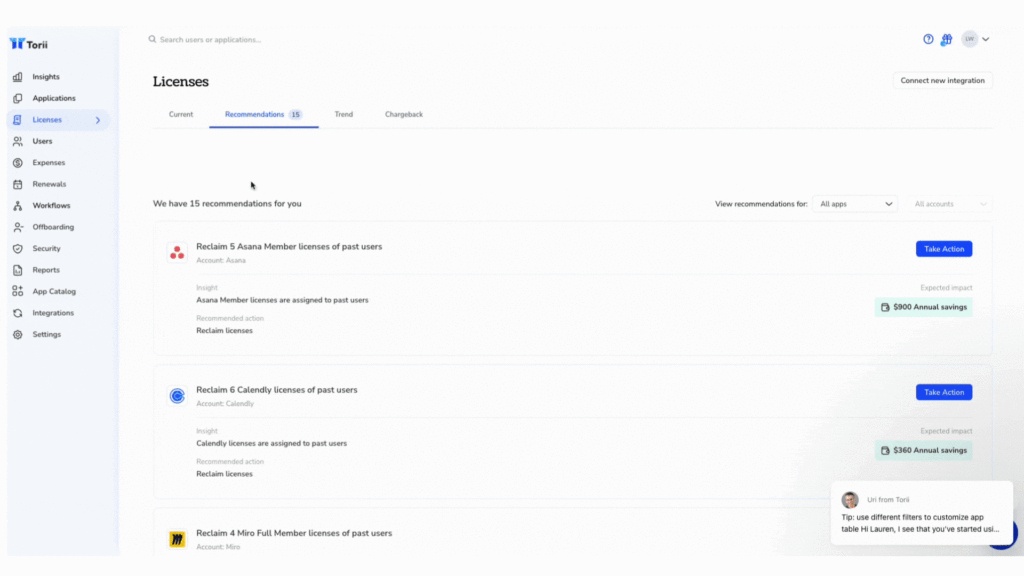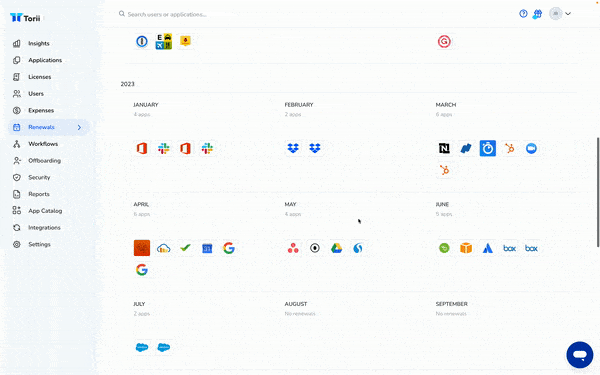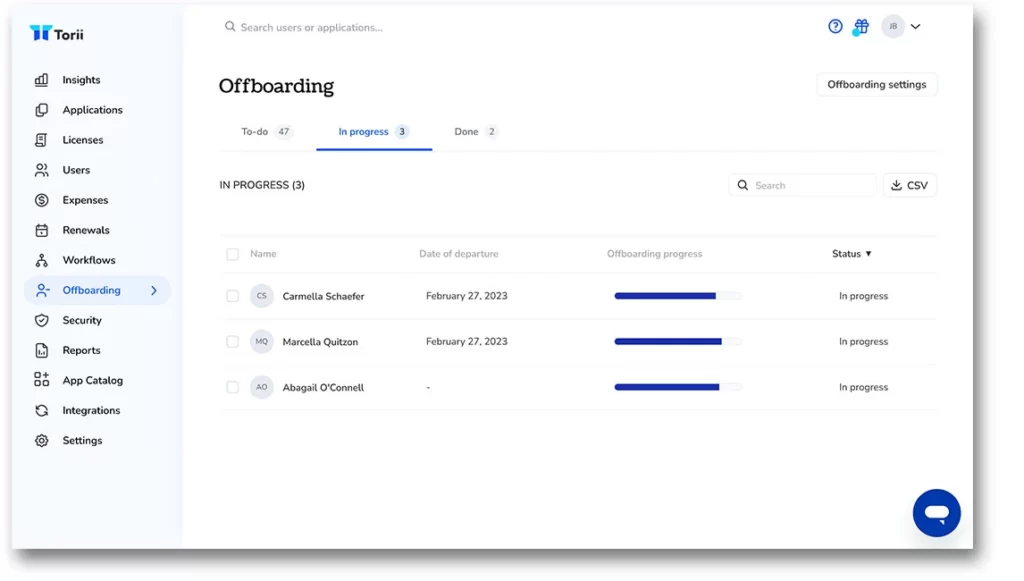If you’re reading this, it might be for one of three reasons:
- You’ve got a creeping feeling that you’re wasting money in the form of idle license seats, and you want to address it now
- You just received a directive from leadership that you need to cut costs fast
- You’re a competitor trying to figure out how Torii got so dang good at helping IT save money on wasted licenses (like how Lunchbox saved $430k in nine months)
Regardless, before we can talk about license management, we need to talk about cloud apps—aka software as a service (SaaS).
SaaS is exciting because it’s easy to try, adopt, and integrate with the company all with a simple subscription! However, those advantages also produce a lot of problems.
In the past, this ease of access encouraged over-provisioning. Lots of apps with lots of seats, but many of those seats are left untouched. Waste like that is overlooked when the economy runs hot, but more recently, as the economy has cooled and uncertainty is introduced, it puts pressure on companies to re-evaluate their SaaS adoption and use.
This article is broken into three parts.
First, we’ll examine the threats of poor license management.
Second, we’ll consider why license management actually relies on SaaS management.
Finally, we’ll go through multiple ways that a SaaS Management Platform can augment or automate your license management process.
Importantly, while this article focuses on SaaS Management Platforms as a solution, you can still take the underlying principles and apply them to your context.
The Threats of Poor SaaS License Management
License management involves keeping track of the different software licenses your organization uses. Often, these license seats are articulated within the agreement or contract with a SaaS vendor. These contracts also outline rules to which your company should adhere.
Poor management can hurt your organization in a variety of ways:
Security threats – Without a license management strategy, companies open themselves to new attack vectors from bad actors and general ignorance. For example, when an employee leaves the company—if their access to SaaS isn’t revoked—they might continue interfering with or stealing intellectual property from the company. They are also less likely to abide by security best practices when using their old company’s software.
Shadow IT – A poor SaaS subscription model can also impact the battle with shadow IT. Poor SaaS contract management can encourage redundant purchases, wasted resources, and less visibility over SaaS services.
Excessive costs – ITAM review estimates that as much as 35% of SaaS spend is lost on idle licenses. This issue is compounded by frequent auto-renewal clauses that many SaaS services contain in their service agreements. As a result, this type of license model burdens your budget for long stretches.
Poor resource use – underutilized apps don’t just hurt the bottom line; they hurt productivity. Valuable resources of time and expertise should only be dedicated to applications that the company leverages.
Non-compliance – Organizations must adhere to the terms and conditions of the software license. These terms can stipulate where and how tools can be used. Poor license management exposes an organization to needless risk.
While all these problems are tied to license management, they also go deeper. They affect every aspect of your entire SaaS stack. In this next section, we’ll examine how SaaS Management plays a role.
Software License Management Starts with SaaS Management
SaaS License management is just a symptom of a deeper problem. As we mentioned at the beginning of the article, your SaaS is likely scattered throughout the organization, and that can cause a severe underestimation of the number of apps present. In fact, we’ve seen customers discover they had 4x as many apps as they expected.
Without visibility into that true number, IT teams can only scratch the surface of proper spending and license management.
To tackle these problems, you must prioritize discovery. There are many methods of discovery, but it’s important to find one that is comprehensive and multi-sourced so that you can verify the data and increase your confidence in the findings. That means methods that incorporate info from your Identity Provider, your SSO, your HR tool, your expense data, and more. The more sources, the more opportunities to solidify your understanding.
An effective discovery system should shine a spotlight on your applications as well as their usage rates, historical trends, costs and more. Without this foundational data, license management efforts will only find middling success.
Once that discovery system is established, you can pull data into your SaaS system of record. From here, you should surface findings and insights that inform all of your cost-saving and operational efforts.
Interested to learn more? Click here to go deep into today’s SaaS Management Platforms (SMP) and how they empower your IT team.
Once you have a SaaS Management strategy in place, here are powerful ways to tackle your license management problems.
Reminder: These solutions are automated or augmented by an SMP, but you can still apply the underlying principles to your context.
Surfacing Your Current License Use
Centralized insight is crucial. That’s why Torii has a designated tab just for all your Licenses. You can find a complete list of every business application in your stack, and alongside each app is a breakdown of the license utilization:
- Active licenses
- Total licenses available
- Inactive licenses
- Unassigned licenses
This breakdown gives you a great place to start your SaaS license management overview.

Tip: Even without an SMP, you can still create a designated “dashboard” from which to view license utilization rates. If you need to collect this data manually, focus on the most expensive and broadly provisioned apps. You might find many employees never even touch these apps.
Consult The Recommendations Engine
Everyone loves a quick win. A good SMP should provide recommendations based on real-time usage data to help you keep costs down—especially with your most expensive apps, such as Zoom and Salesforce. These recommendations are carefully curated to help you identify the most relevant cost savings opportunities.

Tip: Look for license usage on the feature level. Then, take actions like downgrading users who don’t use the features of a higher-tier license (for example, Zoom users who never host meetings over 40 minutes).
Learn more about the Recommendations Engine
Use Chargeback or Shadowback for Transparent Cost Allocation
Often, waste is a symptom of ignorance. For example, teams might not realize how much their underutilized seat costs the company.
Tip: Generate a chargeback/shadowback report based on your cost allocation model and use that report to educate the company on how much its SaaS licenses cost the company. This will increase accountability and encourage forethought about license use.
Learn more about IT Chargebacks
Centralize your License Agreements and Contracts
Your SaaS Management Platform should also serve as your SaaS System of Record. That means you should upload all of your contracts to the system and get a complete perspective on the terms and agreements for each application. Every SaaS license agreement with every SaaS vendor should have a home. This ensures that everything you need to know is available. From the pricing model to the terms of use for the software.

Tip: Create a dynamic renewal calendar that automatically alerts you when a contract renewal is approaching. This gives you the time you need to pull together the data for an informed negotiation.
Learn more about Contract Lifecycle Management
Discover Your (True) SaaS Spend
Be sure to track and visualize all SaaS applications, including shadow IT, and find hidden expenses that might not be associated with an existing contract.

Tip: Sometimes called “shadow expenses,” these costs often go unnoticed, but they’re sometimes tied to duplicate app licenses.
Tip: For similar tools, check out the application comparison tool—this will let you do a side-by-side comparison of your similar apps to find which one is the better value.
Learn more about SaaS Spend Management
Learn more about Application Comparison
Automate Offboarding
Offboarding is a long and complex series of tasks, and license deprovisioning is often skipped or left incomplete. With a SaaS Management Platform, you can either automate deprovisioning or you can delegate the task to the application owner via an automatically generated ticket. That way, you can safely assume that license seats will be reharvested, preventing overspending and reducing security risk. Some organizations see as much as a 60% reduction in total offboarding time.

Tip: If you’re relying on your SSO via the IdP to automate this task, remember that this method only works for known apps, not unsanctioned ones. This is different from a SaaS Management tool which starts with discovery. Be sure to compile a list of all apps and understand which ones will require a manual process.
Learn more about:
- Automated offboarding workflows
- Ticket system integration with Jira and others
- Application owner roles
Conclusion: Time To Manage SaaS
Efficient SaaS license management is not a luxury; it’s a business necessity. It’s not just about managing individual licenses, but about managing your entire SaaS ecosystem. Without a clear view of your SaaS landscape and a comprehensive management approach, you’re opening up your organization to risks and costs.
The course ahead is clear, if you want to prevent costs and threats, it starts with holistic SaaS Management. By employing the steps outlined above, you can ensure visibility, curtail excessive costs, heighten productivity, maintain compliance, and secure your systems. From initial software discovery, through evaluation and implementation, to eventual retirement—every stage of the SaaS lifecycle matters!
Even if you don’t currently use an SMP, these principles apply! You can create your own dashboard, consistently monitor your licenses, optimize cost allocations, and even automate offboarding procedures. The key is to stay proactive and diligent.
Ultimately, poor license management is a symptom of poor SaaS Management. Limited visibility, distributed ownership, and the expansion of shadow IT all contribute to a blurry SaaS ecosystem.
With the right strategies, effective tools, and a dash of automation, your bloated budgets can become a thing of the past.
Looking for some inspiration? Learn how these top companies tackled their spending by implementing SaaS Management.
- Learn how Omnipresent saved 15% on Microsoft 365 and tens of thousands of euros on Zoom licenses
- See how Lunchbox saved $430,000 in just 9 months
- Check out Paxful’s journey of saving $715,000 in licenses
Ready to become the next inspirational success story? Request a demo of Torii and discover just how much you could save through optimized license management. Your journey toward streamlined SaaS management begins here.

